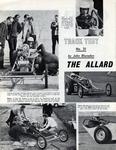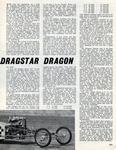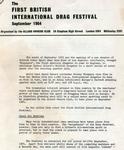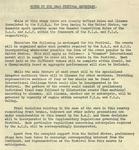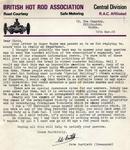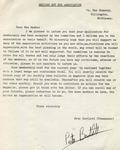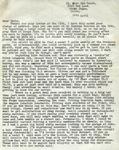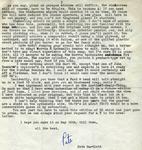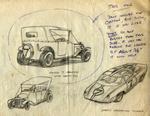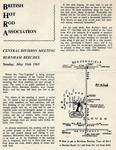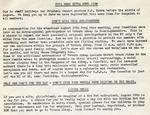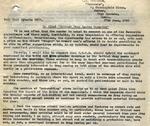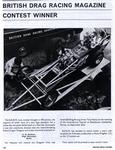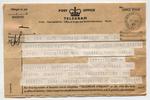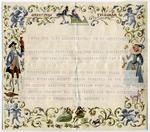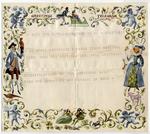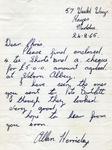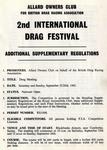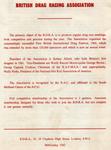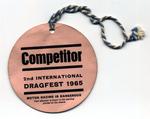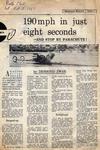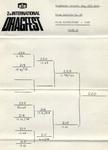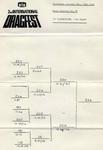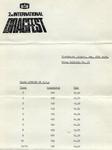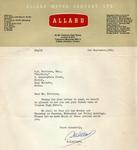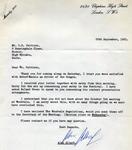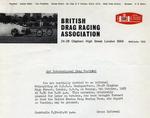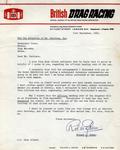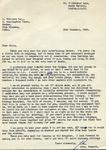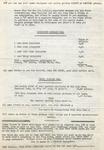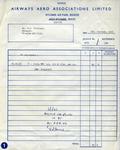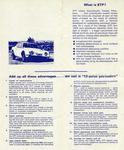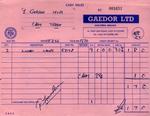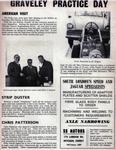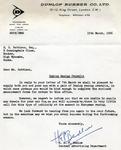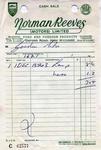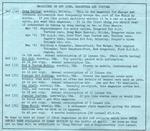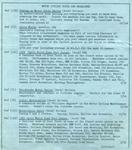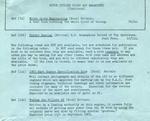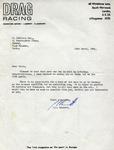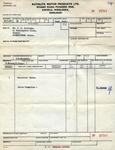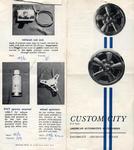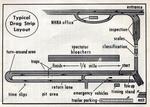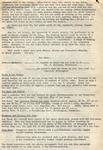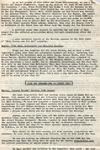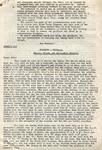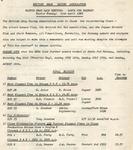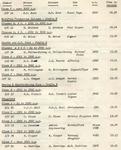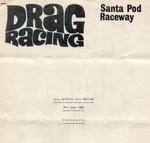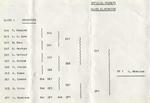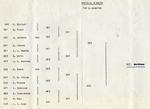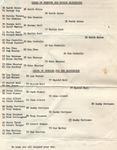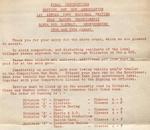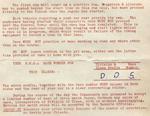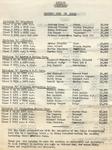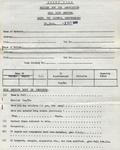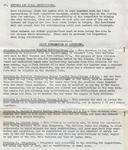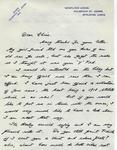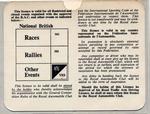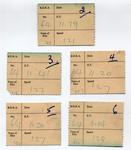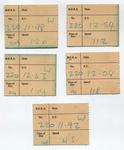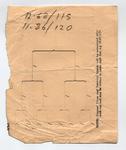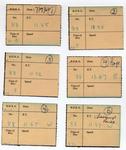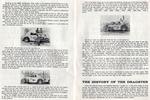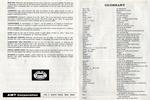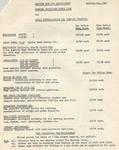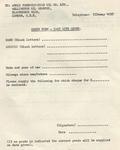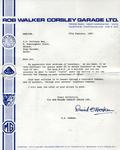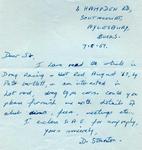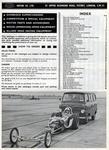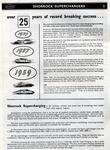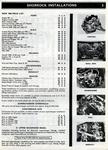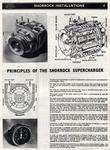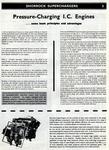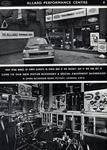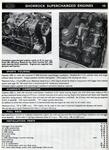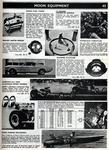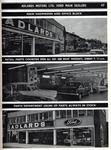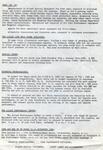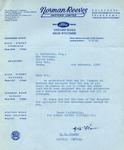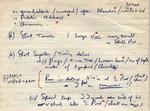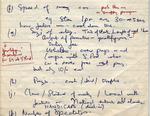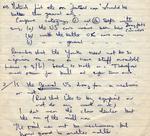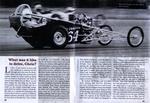
As told exclusively to Brought up in a RAF family, Chris Pattison lived in Hornchurch and was introduced to motor racing by his father who, after retiring from the RAF, ran a country garage. Chris attended the 1964 International Drag Festival at Blackbushe. A major event for him was winning an Allard Dragon dragster in a competition in the British Drag Racing magazine. The car was initially driven by its designer John Hume and Allard works driver Rob Mackie, however Chris first had the opportunity to drive it in Spring 1966. In the first year of Santa Pod, Chris shared the driving with his father, gaining 13 awards from 11 meetings. His entrance to college resulted in the Allard Dragon being exchanged for Alan Ing's roadgoing Turner Climax. Born in the harsh winter of 1947 I am now 74. I was an RAF brat, my father having fought through the war in Hurricanes, Typhoons and anything he could get his hands on but Typhoons were his main weapon of choice. Then in the immediate post-war years he was into the early jets, Vampire, Meteor and Hunter. He met my mother up at RAF Acklington in Northumberland so I’m actually a Geordie by birth. I spent the first 13 to 14 years of my life with my father being in the RAF and in his last posting he ended up as Commanding Officer of the Air Crew Selection Center at RAF Hornchurch. In the meantime, at the age of two he was posted to Ismailia in Egypt where I spent two formative and interesting years. While I’ve no memory of the outward voyage I have clear memories of living there and some memories of the return voyage on the Royal Mail Ship, Empress of Australia, which was on its last voyage prior to being broken up. This vessel was actually built as the Kaiser's private yacht but taken as part of war reparations and ended up with Canadian Pacific. The wood panelling from the smoking room beautifully exists in the visitor's reception room at the Glenlivet Scotch distillery. My mother was 20 when I was born. My Father flew out with his Squadron to Ismailia and my mother and I went from Whitley Bay to Harwich, then to the Hook of Holland. Then it was the Transcontinental express but I think it averaged about 20 mph all the way to Trieste, going through occupied Berlin and again I’ve no memory of this. It's what my mother told me and we were well turned over by the Russians who weren't very pleasant people to deal with at the time, apparently. Then from Trieste a ship to either Alexanderia or Port Said. I loved Egypt and we came back to Britain in November, shivering on the return saying I want to go home because home was hot and there were beaches and warm waters. From then on to RAF Tangmere, RAF Odiham then to dwellings in Civilian Hirings in Wembley then Sidcup while my father did two tours at the Air Ministry helping develop Firestreak and Fireflash air-to-air missiles. He was always a weapons specialist. Finally ending up going to Hornchurch. He retired from the RAF at the age of 39 having done 21 years service and got the DFC and various other awards. He’d always been interested in motor racing and when we lived at Sidcup, for instance, we used to go to Brands Hatch and Stock car racing at Wembley, which was always enormous fun. I remember the likes of the Wardropper father and son team with their Jaguar XK engined cars amongst all the Flatheads and occasional OHV V8s. When we were at Tangmere we used to go to Goodwood, this was all the prime time of the 1950’s so again strong memories of those episodes. Educationally I’d passed my eleven plus and gone to a couple of Grammar schools. One of which was the Davenant Foundation Grammar School for Boys in Whitechapel High Street in the East End from 1959 to 1961 when the Krays were running the manor and their home was Vallance Road two blocks down from the school. I did have a third hand acquaintanceship with them but that’s another story entirely and all to do with Lady Chatterley's Lover! Backtracking slightly at RAF Hornchurch my father was one of the first to get Kart racing going in this country because in 1959 he allowed Kart racing to take place on the apron between the hangars, and of course that’s how lots of American Servicemen got involved. It was actually quite a strong scene but that was the very beginning of it, and I saw it. I crashed my first Kart when I was 11! My Father also started a Gliding Club while we were at Hornchurch. So my first introduction, which endeared me to V8 engines thereafter, was helping to rebuild a Ford V8 Flathead for the glider winch that we built up. Hornchurch is next door to Dagenham so it was relatively easy to find engines from the Ford Pilots kicking around at the time, but even then, getting spares for them was more difficult than it is now. I think it was Nordian Engineering that seemed to be able to acquire them even having contacted Ford’s at Dagenham. It was great, I learnt to glide and did most of my gliding between the ages of 11 and 13, soloed at 16 and didn’t do anything much subsequently. The glider winch was wonderful sitting in there listening to the V8 bellowing away behind you. It was rev'd up to the maximum for a short period to hoist the glider to typically 800 feet altitude then they’d drop the cable. What was quite entertaining was sitting in a wire cage so if the cable ever broke you were protected from its flailing end. There was a big handle which operated a guillotine so if the cable got hung up on the glider and couldn’t release you could chop it off! Retiring from the RAF my father wanted to get into the garage business and prior to retirement he’d taken lessons in mechanics and bookkeeping at evening class. The RAF were good at sponsoring this sort of thing and whilst we were at Hornchurch, he also started a tool club. On a weekly basis we’d buy Britool tools at a discount and happily I’ve still got all of his tools and have put them to good use in the intervening years. He went into partnership with Lawrie Bond, of Bond Mini car fame, at the garage called Lawrence Bond Cars, Loxwood in Sussex. We lived in a nearby village and Lawrie Bond, whilst mainly remembered for the Mini cars, was a very gifted engineer. Even more than Colin Chapman he was always in search of lightness, and he would add it to anything he built. He built a little front wheel drive Formula 3 500cc car but later while we were at the garage, he built a Formula Junior car with a 105E engine but as a front wheel drive. A beautiful thing it looked like a miniature Vanwall only prettier, like Chapman's original Lotus Elite it was a pure glassfibre monocoque. There was one complete car then the moulding for the second car. He’d also built up the casting boxes for the moulds for the transfer gearbox to get to the FWD and also wheels with integral drums like a Bugatti or Cooper for instance. On occasion, when the local Police Sergeant let it be known he was otherwise occupied for the afternoon we’d actually run the Formula Junior up the road to Alfold Crossways, turn round and come back again down the public road. His way of saying he’d turn a blind eye! The second Junior was built up in recent times and both have been raced successfully, even winning some 60 years after their conception. At the crossroads was the Crown pub run by the father of the late David Beckett who bought a Lister Jaguar when he was about 21 and raced it for the rest of his life. From memory I believe he paid a £1000 for it, a large amount at the time but what an investment! By contrast, my mother paid £225 for a Cooper Bristol sports racing car, reputedly the only one ever driven by Juan Manuel Fangio, and I would occasionally be driven to School in it! It's still racing, albeit with an MG engine but still with a value of a million quid. Wish it was still in the family... The garage ran very successfully until Lawrie Bond went off as his marriage collapsed to Pauline, a lovely lady who made the best gin and tonic in the world. He went off to the Lake District with Dreyfus QC’s wife and pretty much drank themselves to an early grave. Dad found another garage with another partner at High Wycombe which is where I have lived for 55 years now. Then he had the opportunity to manage the local airfield at Booker which became the busiest general aviation airfield in the country which is where I met my good friend Tony Bianchi who still races the Farrellac Caddy engined Allard he has owned for 47 years. The ironic thing was when we were both girl chasing the only road worthy vehicle we had between us was my 1933 Model Y Ford, registration JE33, wish I still had that. We used to go to the Club Continental in the Dolphin Hotel, Maidenhead to pick up ‘au pair’ girls. Tony has had an incredibly successful career restoring, building and flying Historic aircraft, including Spitfires. He captained the British Aerobatic Team and has restored and raced Vintage and Historic cars for the last 55 years. I’m not sure when I first became aware of hot rods but was certainly enlightened when I discovered Hot Rod Magazine in 1961 and the exotic world of drag racing. Naturally I was excited to attend the First International Drag Festival at Blackbushe in 1964 and was totally blown away by the sights, sounds and smells of the visiting American cars. It was an overwhelming sensory overload compared to the circuit racing I'd seen at Goodwood and Brands Hatch and the Stock Car Racing at Wembley and Wimbledon. Thus it was with huge enthusiasm that I entered a competition to win the ex-works Allard Dragon slingshot dragster in the June 1965 edition of the newly published British Drag Racing Magazine edited by Roland Green. Imagine my ecstatic reaction to receiving a Telegram on 23rd August 1965 telling me I’d actually won. I was high as a kite on the adrenalin, and I played Jan and Dean's ‘Drag City’, a 45 record, over and over during that day.
An announcement of my win was published in the September 1965 issue of BDRM followed by meeting the car at the National Model Exhibition at the New Horticultural Hall, Westminster. At the same time, I was offered lubricant sponsorship by Valvoline and on the back of that cheekily asked Dunlop for two pairs of Proban overalls for my father and myself. They readily agreed as the Dragon ran RS5s on the rear. I still have the overalls which form a strong contrast with the Stroud Top Fuel suit I have been using latterly. I don’t think poor old Sydney was ever paid for the Dragon by the magazine, he had to give it away. Roland Green was an odd character and me and my Father nearly fell out with him. For those unfamiliar with the genesis of the Dragon herewith a short synopsis. It was conceived by Sydney Allard and John Hume as an inexpensive kit costing £600 complete in 1964. A Lotus Cortina would set you back £1100 at the time. On the 8th of April 1964 the Dragon was introduced to the press at Silverstone, turning 12.47 for the quarter with its methanol burning 173bhp Shorrock supercharged 1498cc pre-crossflow Ford Kent engine. The car weighed 560lb and had cost £1000 to develop. Just two months later, at Chelveston, it set International Class F standing quarter mile and Kilo records held by Mickey Thompson. Thompson’s Kilo average speed was 91.36mph which was raised to 104.04mph average in 21.5 seconds and cut the quarter in 11.54. In September the Dragon was demonstrated at the Italian Grand Prix in Monza in front of 100,000 spectators showing acceleration that far outclassed the contemporary Grand Prix cars. It then competed in the Drag Festivals running a best of 11.26 at 129mph. The closest American equivalent was the beautiful Porsche engined dragster of Doug Church. In February 1965 the car was flown to the USA courtesy of Ford to compete in the NHRA Winternationals. The Americans were incredibly impressed by the performance of the tiny 90 cubic inch 4-banger. From there it returned to Europe to appear at the Stockholm Auto Show having travelled some 18000 miles in 16 months!
After the car was returned to Allards from the Motor Show my parents and I visited Clapham in early September 1965 to meet the Allards and be educated about maintenance requirements. It was a great privilege to meet Sydney, Alan and John Hume and gawp at the massed silverware on display reflecting their many successes in a vast variety of motorsports. We also had a first glimpse of the new stainless steel framed dragster which was to become the second Allard Chrysler slingshot and later achieved much success in the hands of Clive Skilton as Revolution. The Second International Drag Festival was held over just two rounds at Blackbushe 25th-26th September and Woodvale on the 3rd October 1965. The Dragon was officially handed over to me by the US Drag Racing legend Tony Nancy who wished me ‘Good luck with your new car’. The Blackbushe meet was incredibly wet and the US visitors demonstrated great skill and bravery splashing through the standing water at up to 179mph. As the car owner I was now the entrant but not yet the driver, that pleasure was yet to come. The chosen ‘shoe’ was 25-year-old Rob Mackie, Allard’s Works Rally driver who had competed with Alan Allard in four Monte Carlo Rallys and was a class winner in the Liege event. I had met him at a Graveley practise meet where he had his first drive in the Dragon and initially did not like it at all. In the Daily Mail of 2nd October 1965, he was quoted as saying, ‘It was a most unpleasant sensation, but when you stopped and the blood started circulating again you knew you were itching for the next battle.’ Being the professional he soon got to grips with the car and put in sterling performances. Interestingly I remember Alan saying he preferred driving the big Chrysler slingshot as it was easier... less busy I guess, none of that messy gear shifting stuff, of which more anon. Incidentally, John Hume made the quickest run while the car was in Allard ownership at the British Hot Rod Association 2nd Big Go at Duxford 6th June 1965. The elapsed time was 10.997 seconds but recorded as 11.00 in the results and the car was always emblazoned with ‘129mph in 11.11’ on the cockpit. The 10 second run was not publicised at the time because it was felt it would not be believed. Drag Festival over we finally got to tow the Dragon back to High Wycombe behind my father’s MG1100, soon to be replaced by a Jensen 541R. We fired up the Dragon on the apron at Wycombe Air Park, with my friend Tony Bianchi (well known to all you Allardistes) in the cockpit to check out a clutch problem. It transpired that the clutch pressure plate was warped and despite contacting the flywheel over only one third of its circumference it still did not slip. It was a Porsche Carrera unit and a replacement was obtained from Allards.
Just prior to Christmas I had a request from John Bennett, prime mover behind Santa Pod, to borrow the Dragon for a BHRA bash at the Phillips Factory in Croydon where the BHRA held slot car drags. The gig was that the car was a sleigh for ‘Mother Christmas’ who was in fact John’s attractive wife Ann. My father was busy running the airfield at weekends so it was arranged that Allan ‘Bootsie’ Herridge and John Harrison would transport the car in their Dragster Developments 1950 something Austin K8 van. I'd already made their acquaintance at the Woburn Abbey Rally of the Giants earlier in the year and remain to this day a firm friend of Brian Sparrow, the third founder of Dragster Developments and as with Allan, inducted into the British Drag Racing Hall of Fame. I had also hand-painted team T-shirts for DD charging them £5 for five shirts. We manhandled the Dragon into the back of the van where it rested on the back wheels and the oil pan. Allan in his strong Laaahndun accent asked me ‘Ere Chris, ‘as it gotta still sump?’ I thought still? Well it’s not going anywhere, then realised he was saying 'steel sump’ on which it was safe to rest. The event was a great success and Mother Christmas was well received. March 19th 1966 saw us at Graveley practise meet for my first drive. Dear Bootsie acted as my mentor. He said: ‘Chris, if you don’t like it just back off’. So without further ado I was push started by somebody else's car as we hadn’t got a push board on the Jensen. It cracked into life on the hard plugs, having warmed it up on the softs, and I staged. A wave of the flag and 11.98 seconds later it was all over and I loved it. I'd just driven twice as fast as I ever had in my life. Now let's put that in perspective. I was 18, my daily driver was a 1933 Model Y Ford, I'd taken my driving test and passed at 17 and a quarter, in the BSM HA Vauxhall Viva and that was about it. Fast road cars such as Jaguars and Ferraris were in the 15-17s bracket and it wasn’t until the Cobra demonstrated 13 second quarters that things began to perk up. Difficult to believe these days when a mid-range motorcycle will cut a 10 second quarter at very little expense and mundane family cars offer as much performance as a Jaguar E-type. Pity it’s all so wasted on today's roads. I like to think I made the third ever run at Santa Pod after Ken ‘Flathead’ Cooper faced off against Harold Bull in Stripduster. This may be false memory, but I clearly remember thinking Santa Pod, with its barriers, was very narrow after the wide-open spaces of Graveley and Duxford. An American commented ‘We’d run cars four abreast on a track this wide’ just to correct me. My father and I agreed that I would drive at British Hot Rod Association events and ‘Daddy Pattison’ at British Drag Racing Association meets. This worked very well and looking back at a couple of timing slips was a best of 11.14 which I willingly concede to the old man. He was a former RAF Fighter Pilot and had the reflexes of a greased weasel on speed. At the end of the season we had garnered 13 awards from 11 meetings from memory. At best the awards would comprise Top Eliminator, Class Eliminator, and FTD. Incidentally as entrant I received £97 prize money from the Dragfest.
Being the ex-works car, it was reliable and easy to run. Regular maintenance included oil changing every four runs and new big end bearings and cap bolts every ten runs. Methanol was seven shillings and six pence (37½p) a gallon from the High Flash Petroleum Company in Croydon and I remember poisoning myself with fumes from the fuel when carting it back in my Model Y. Five gallons would easily last a couple of meetings whereas my current alky-burning blown big-block Chevy gulps a reassuring 8-10 gallons per mile. Such was the paucity of reliable competition at the time that Harold Bull and I would stage impromptu match races to fill in gaps in the scheduled racing. We’d just nod to each other, strap in, fire up and nod to the starter. It was all cool with the Clerk of the Course as it kept the spectators entertained. Furthermore when my father was driving I'd push start him with the Jensen and Harold’s, then about 15-year-old son, would do the same for Stripduster with their Mk 9 Jaguar. When the dragsters had cleared the strip we would totally unofficially stage the Jensen and the Jaguar, nod at one another and a push-car race was on. Can't get away with stuff like that these days.
I do remember once towing to Santa Pod when Harold overtook us doing about 90mph with his trailer on the back. Another incident was when Brian Witty lost his dragster off the back of his trailer and tossed it through a greengrocer's window. Fortunately it was a Sunday and the shop was closed. Another time, and this was a lovely memory, I was racing Brian Witty in the Dragon doing all my gear shifting bits and I hauled by him quite nicely. He had a Ford Y block in his car, it was never very quick but a good looking car. I looked across and he looked at me. He came up to me afterwards and said: ‘for god's sake Chris what have you got in that?’ It was just a lovely moment. Another sign of informality of the times was the fact that my mother and Ann Bennett would sit in the shade of the control tower, which was on the start-line, on lawn chairs, chatting and knitting. John Bennett was very friendly and I’ve always felt he never really received the recognition he deserved for instituting Santa Pod. A particularly pleasant interlude was an invitation to appear at Debden Gala of Motorsport on the 18th-19th June 1966. It was delightfully warm and my parents and I stayed with an ex-RAF colleague, Flt/Lt. Pete Child, in his gorgeous black and white Tudor house. The runway offered a lot of traction and Allan Herridge was seen to be oiling his Goodyear slicks on the Cadillac powered Pulsation dragster. The highlight for me was being pitted alongside Donald Campbell with Bluebird CN7 which was to have made some medium speed runs along the main runway. However, on the day before my arrival, Donald had handed over the controls to Peter Bolton (died 2008 at 88). He was an experienced racing driver and had indeed notoriously tested the Daytona Cobra at 193mph on the M1. Although it was all perfectly legal at the time many held that this amongst other factors was partially responsible for the introduction of the 70mph speed limit. I am unclear as to why Donald handed over the driving as he was famously superstitious, protective and jealous of his driving seat. It may be that chronic back pain that afflicted him as a result of a monumental crash at Bonneville in 1960 was troubling him sufficiently to hand over the task.
Surprised and delighted to be pitted alongside him, as soon as we had unloaded the Dragon he came over, shook my hand and rather needlessly but politely introduced himself. Now, Donald had been one of my boyhood heroes along with the likes of Peter Twiss, John Derry, Neville Duke and other luminaries of the Jet Age. Do schoolboys have heroes such as those these days, or dubious role models? I was mindful of his reputation for occasional irascibility, perhaps due to the aforementioned pain, but he was charming, affable and took a great interest in my little car and its teenage driver, asking a great many questions. He then took me over to Bluebird and introduced me to his glamorous Belgian wife, Tonia, his venerable chief mechanic, Leo Villa and others in his team. He showed me round Bluebird and even invited me to sit in the cockpit. What was remarkable about all this was that the previous day Peter Bolton had succeeded in achieving something like 200mph at an altitude of a few feet, having run off the end of the runway and flown through the boundary hedge, crossing the main road, fortunately without hitting anybody on the way. This is possibly because he was used to the instant throttle response of a racing piston engine but not the slow spooling up of a gas turbine, followed by its relentless impetus and then equally slow spooling down on a closed throttle and lack of engine braking. The subsequent damage to CN7 was surprisingly light but derangement of suspension and brakes resulted in succeeding demonstrations limited to trickling down the runway at no more than 30mph. In light of all this Donald would have every right to be incandescent with rage or plunged into the depths of depression to which he was also prone. Instead, he took the time to show interest in a teenage drag racer and his car, leaving me with an abiding memory of a smiling, engaging and wholly human hero. On 4th January 1967 he tragically lost his life in K7 making an attempt on the World Water Speed Record on Coniston Water. My late Aunt Iris clearly heard the crash whilst tending her sheep on the fell with her elderly shepherd Tommy who remarked to her ‘That booger’s done it now...’ August Bank Holiday weekend saw the BHRA Drag Racing Championships Meeting. Because of lack of competitors at the time it was held for the first and only time on a handicap basis which led to some lively correspondence between Brian Sparrow (vehemently against) and Denis Jenkinson (broadly in favour). The handicap was based on practise times and relied on expert knowledge by the handicapper of the car and driver to avoid sandbagging on the day. Strangely, the starting lights (not quite a Christmas tree at the time) were initially used for practise only and a flag-starter for racing. I was drawn against the small but very effective Rudge powered Wicked Lady mini dragster (not a kart) of Tony Gane and Dennis Priddle, Tony was driving. The upshot was I sat on the line watching Tony disappear down the track waiting for the near three seconds handicap to elapse, an eternity in drag racing. I stormed after him fouling up the cross gate 2nd (starting gear) to 3rd shift resulting in my losing. Entirely my fault, hugely frustrating and the loss of becoming the first UK National Champion. Heads up racing is the only way to go in Pro Classes and Championships. The irony is that I set FTD at 11.59 that day and given good starts and no missed shifts that would have been good enough to secure me the Championship, but hey, that’s driving and racing.
Having chosen to study Mechanical Engineering at College I decided the Dragon had to go and by then it needed a rebuild which I felt I could not afford. Accordingly I eventually agreed to a straight swap with Alan Ing for his Turner Climax with a rare FWB engine, another car I wish I still had. Alan was a mechanic with a Ford Main Dealer and with his mechanical and driving skills went on to win the Championship in 1967. After that, racers had got a handle on tuning V8s and Allan Herridge took top honours the following year in Motovation with a small block Chevy. In the meantime Alan Ing was dipping into the high 10s, testament to his talents in a small and by then aging machine.
I have no knowledge of what happened to the ex-Works Dragon after Alan Ing finished with it and would be grateful for any clues. It was a truly historic car in the context of British drag racing and worthy of preservation. Adrian Sidwell has good reason to believe he has the Shorrock blower from it on his Opus HRF roadster. It is possible that three frames each of the two Marks of Dragon were constructed, one of each being for exhibition and publicity purposes. The Mk 2 being restored by Roger Hayes may be the Colin Glass/Denis Jenkinson, Bristol engined example. The sister Mk 1 Dragon was run by Gerry Belton, Ian Smith, Denis Jenkinson, Pete Atkins, Doug Harler, John Rotherham and is still being campaigned in the capable hands of Alan Smith albeit with modern sequential gearbox which he readily admits cost more than the rest of the car put together... Oh to have had that in 1966... At the start of this video, we see Chris and his father driving the Dragon, also the Jensen 541R and Windpusher Turner Climax... Gallery: click on any thumbnail for a large image.
Back to pioneers index Back to News page |











































